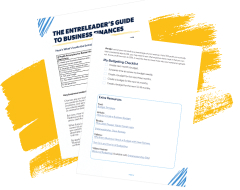How to Create a Basic Business Budget
8 Min Read | Apr 24, 2025

Key Takeaways
- Write down your revenue streams. List every way your business makes money—no numbers yet, just sources.
- Write down the cost of goods sold (if you have them). If you sell products, note what they cost you.
- List your expense categories. Track all business expenses, big and small, so money doesn’t slip through the cracks. Common categories are payroll, rent, utilities, insurance, supplies and equipment, marketing, technology, and training.
- Fill in your own numbers. Use actual or estimated amounts to build a clear financial picture. Hint: You can use past profit and loss statements to inform what you expect to bring in. Your budget combines that guesswork with history of expenses to give you a more realistic picture.
- Calculate your expected profit (or loss). Subtract expenses and costs from revenue to see where you stand. Here’s what that calculation looks like: Revenue – Expenses – Cost of Goods Sold = Profit or Loss
- Review your budget often. Check weekly to stay on track and monthly to compare with actuals.
- Work toward a 12- to 18-month budget. Start with one month, then keep going for better long-term planning.
You’d never intentionally set your business up to fail, right? But if you don’t know your numbers and how to make a business budget, that’s exactly what you’re doing. Money problems and bad accounting are two reasons why many small businesses don’t make it past their first five years.1
Talking about budgets can feel overwhelming. We get it. For a lot of business leaders, it’s a lot more comfortable dreaming up big ideas and getting stuff done than digging into numbers. But you can’t set yourself up for steady growth until you have a handle on the money flowing in and out of your company. You also can’t enjoy financial peace in your business.
Not a numbers person? That’s okay. Follow the simple steps below to learn how to create a budget for a business and manage your finances with confidence. We’ll even give you a link to an easy-to-use small-business budget template in the EntreLeader’s Guide to Business Finances.
But before we get to that, let’s unpack what a budget is and why you need one.
Don't Let Your Numbers Intimidate You
With the EntreLeader’s Guide to Business Finances, you can grow your profits without debt—even if numbers aren’t your thing. Plus, get a free business budget template as part of the guide!
What Is a Business Budget?
A business budget is a plan for how you’ll use the money your business generates every month, quarter and year. It’s like looking through a windshield to see the expenses, revenue and profit coming down the road. Your business budget helps you decide what to do with business profit, when and where to cut spending and grow revenue, and how to invest for growth when the time comes. Leadership expert John Maxwell sums it up: “A budget is telling your money where to go instead of wondering where it went.”
But here’s what a business budget is not: a profit and loss (P&L) report you read at the end of the month. Your P&L is like a rearview mirror—it lets you look backward at what’s already happened. Your P&L statement and budget are meant to work together so you can see your financial problems and opportunities and use those findings to forecast your future, set educated goals, and stay on track.
Why Do I Need to Budget for My Business?
Creating a budget should be your very first accounting task because your business won’t survive without it. Sound dramatic? Check this out: There are 33.2 million small businesses in the United States. Out of the small businesses that opened from 1994 to 2020, 67.7% survived at least two years. But less than half survived past five years.2 The top reasons these businesses went under? They hit a wall with cash-flow problems, faced pricing and cost issues, and failed to plan strategically.3
As a business owner, one of the worst feelings in the world is wondering whether you’ll be able to make payroll and keep your doors open. That’s why we can’t say it enough: Make a business budget to stay more in control and have more financial peace in running your business.
A budget won’t help you earn more money, but it will help you:
- Maximize the money you’ve got
- Manage your cash flow
- Spend less than your business earns
- Stay on top of tax payments and other bills
- Know if you’re hitting your numbers so you can move at the true speed of cash
Your Road Map to Grow Your Business
Dave Ramsey’s new book Build a Business You Love is now available for purchase! This book will walk you through the same proven system Dave Ramsey used to build Ramsey Solutions from a card table in his living room to a $250 million company.
How to Create a Budget for a Business
Your ultimate goal is to create a 12- to 18-month business budget—and you will get there! But start by building out your first month. Don’t even worry about using a fancy accounting program yet. Good ol’ pen and paper or a simple computer document is fine. Just start! Plus, setting up a monthly budget could become a keystone habit that helps kick-start other smart business habits.
Here’s how to create your first budget for business:
1. Write down your revenue streams.
Your revenue is the money you earn in exchange for your products or services. You’ll start your small- business budget by listing all the ways you make money. Look at last month’s P&L—or even just your checking account statement—to help you account for all your revenue streams. You’re not filling in numbers yet. Just list what brings in revenue.
For example, if you run an HVAC business, your revenue streams could be:
- Maintenance service calls
- Repair services and sales
- New unit installation
- Insulation installation
- Air duct cleaning
2. Write down the cost of goods sold (if you have them).
Cost of goods is also called inventory. These expenses are directly related to producing your product or service. In the HVAC example, your cost of goods would be the price you pay for each furnace and air conditioning unit you sell and install. It could also include the cost of thermostats, insulation and new ductwork.
3. List your expense categories.
It’s crazy how much money can slip through the cracks when we’re not careful about putting it in the budget. Think through all your business expenses—down to the last shoe cover your technicians wear to protect your customers’ flooring during house calls. Here’s a list of common business budget categories for expenses to get you started:
- Payroll
- Rent
- Utilities
- Insurance
- Office supplies and equipment
- Marketing
- Technology services
- Training and education
Related articles:
Product Launch: 10 Questions to Ask Before You Launch a New Product
New Product Launch: Your 10-Step Checklist
4. Fill in your own numbers.
Now that you have a solid list of revenue and expense categories, plug in your real (or projected) numbers associated with them. It’s okay if you’re not sure how much you’ll sell just yet or exactly how much you’ll spend. Make an educated guess if you’re just starting out. If your business has been earning money for a while, use past P&L statements to guide what you expect to bring in. Your first budget is about combining thoughtful guesswork with history and then getting a more realistic picture month over month.
5. Calculate your expected profit (or loss).
Now, number nerds and number haters alike—buckle in. We’re about to do some basic accounting so you know whether you have a profit or loss. This is your chance to figure out exactly how much you’re spending and making in your business.
Take your gross revenue (the total amount of money you expect to make this month) and subtract your expenses and cost of goods sold to find your profit or loss. Here’s what that calculation looks like:
Revenue - Expenses - Cost of Goods Sold = Profit or Loss
Don’t freak out if your first budget shows a loss. That actually happens a lot with your first few monthly budgets. You’re learning and getting context on what’s coming in and going out so you can make adjustments. Keep doing your budget, and before you know it, you’ll be a rock star at telling your money where to go, planning for emergencies, investments and opportunities, and building momentum.
6. Review your budget often.
Whew! Once you get that first business budget under your belt, take a deep breath and celebrate. You’ve just done something huge for your business! (You’ll also be happy to know, budgeting gets easier from here since you can copy and paste your first one and tweak your income and expenses each month.)
But here’s the thing: Your budget can’t just sit in a drawer or on your computer. You’ve got to look at it consistently to make sure you’re actually following it.
Weekly Review
At least once a week, someone in your business (whether it’s you, a qualified team member or a bookkeeper) needs to track your transactions so you know what’s happening with your money all month. Then you can make adjustments before you have more month than money.
Every time you review your budget, ask yourself these three questions:
- Are we on target to hit our revenue goal this month?
- If not, what we can change to get there?
- Are there any expenses we can cut or minimize?
Monthly Review
You also need to review your business budget when you close your books every month to compare it to your actuals—your P&L. Otherwise, how can you know how you’re doing?
7. Work toward a 12–18-month budget.
Now that you’ve created your first month’s budget, move on to the next one. You’ve got this! The more budget-building reps you get in, the better you’ll be at looking forward and planning for growth. In no time, you’ll reach that ultimate goal of a 12–18-month budget. Just keep adjusting as you go based on all you’re learning about getting an accurate road map for your finances.
As you start owning your numbers, remember: It’s okay if you’re a little intimidated by the process of accounting and making a budget for business. But it’s not okay to avoid the financial details that will make or break you. So just keep applying the basics we covered and keep moving forward.
Next Steps
Follow the steps above to create your budget, and review it often to stay on track.
Want a tool to make budget building simpler? Check out the EntreLeader’s Guide to Business Finances. It includes an easy-to-use small-business budget template in the extra resources section.
-
What are the benefits of budgeting?
-
Does using a small-business budget template save time?
-
How do I budget if I own a seasonal business?


